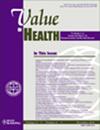Costs and Outcomes After Primary and Revision Hip Replacements by Implant Bearing Materials: Analysis of 550 760 linked Patient Records from English Routinely Collected Databases
IF 6
2区 医学
Q1 ECONOMICS
引用次数: 0
Abstract
Objectives
We investigated 10-year revision risks, hospital admission costs, and quality of life for patients in the year after elective primary and revision total hip replacement (THR), overall and by implant bearing materials and fixation combination.
Methods
We analyzed linked National Joint Registry, Hospital Episode Statistics, and Patient Reported Outcome Measure databases for adults undergoing elective primary THR in England (2009-2018). Implants were classified by bearing material combinations (cobalt chrome and stainless steel, delta or alumina ceramics, and highly or nonhighly crosslinked polyethylene [HCLPE]) and fixation (cemented, uncemented, and hybrid). We estimated hazard ratios with flexible parametric survival models, and generalized linear models for costs and quality of life. Missing quality-of-life data were imputed using multiple imputation.
Results
We analyzed 550 760 elective primary (mean age = 69, SD = 10.7) and 9590 subsequent revision THRs. On average, a primary THR costed, £10 365 (95% CI £10 350-£10 381); quality of life after primary was 0.786 (95% CI 0.785- 0.786), and 10-year revision risk was 2.4% (95% CI 2.08%-2.78%). First and second revisions costed, on average, £20 387 and £24 290, with mean quality-of-life scores of 0.609 and 0.502, respectively. Compared with cemented cobalt chrome and stainless steel on HCLPE, cemented delta-on-HCLPE, uncemented delta-on-HCLPE, and hybrid delta-on-HCLPE, alumina-on-HCLPE, delta-on-delta and alumina-on-alumina were associated with lower 1-year costs, improved quality of life, and lower 10-year revision risks.
Conclusions
Revision surgery costs double than that of an elective primary with drastically lower quality of life. Bearing materials and fixation were associated with varying 1-year costs, quality-of-life scores and revision risks. Although observational data may be affected by unmeasured confounding, our findings could help guide procurement decisions given changing trends in implant choice.
通过植入材料进行初次和翻修髋关节置换术后的成本和结果:来自英语常规收集数据库的550,760例相关患者记录分析
目的:我们调查了选择性原发性和翻修性全髋关节置换术(THR)后患者的10年翻修风险、住院费用和生活质量,包括全髋关节置换术和假体承托材料和固定物组合。方法:我们分析了英国(2009-2018)接受选择性初级THR的成年人的国家联合登记处、医院事件统计数据和患者报告的结果测量数据库。种植体根据承载材料组合(钴铬和不锈钢[CC/SS],三角或氧化铝陶瓷,高度或非高度交联聚乙烯[HCLPE])和固定(胶结,非胶结和混合)进行分类。我们使用灵活的参数生存模型和成本和生活质量的广义线性模型来估计风险比。缺失的生活质量数据采用多重输入法进行输入。结果:我们分析了550,760例选择性原发性(平均年龄=69,SD=10.7)和9,590例后续修订的thr。初级THR的平均成本为10365英镑(95%置信区间为10350英镑至10381英镑);原发性生活质量为0.786(0.785,0.786),10年修订风险为2.4%(2.08%,2.78%)。第一次和第二次修订的平均成本分别为20387英镑和24290英镑;平均生活质量得分分别为0.609和0.502。与CC/ ss - hclpe胶结相比,hclpe -三角胶结、非hclpe -三角胶结、混合hclpe -三角胶结、铝- hclpe -三角胶结和铝-氧化铝-氧化铝胶结的1年成本更低,生活质量更高,10年翻修风险更低。结论:翻修手术的费用是选择性原发性手术的两倍,而且生活质量大大降低。轴承材料和固定与不同的一年成本、生活质量评分和翻修风险相关。虽然观察数据可能会受到未测量的混杂因素的影响,但我们的研究结果可以帮助指导种植体选择变化趋势的采购决策。
本文章由计算机程序翻译,如有差异,请以英文原文为准。
求助全文
约1分钟内获得全文
求助全文
来源期刊

Value in Health
医学-卫生保健
CiteScore
6.90
自引率
6.70%
发文量
3064
审稿时长
3-8 weeks
期刊介绍:
Value in Health contains original research articles for pharmacoeconomics, health economics, and outcomes research (clinical, economic, and patient-reported outcomes/preference-based research), as well as conceptual and health policy articles that provide valuable information for health care decision-makers as well as the research community. As the official journal of ISPOR, Value in Health provides a forum for researchers, as well as health care decision-makers to translate outcomes research into health care decisions.
 求助内容:
求助内容: 应助结果提醒方式:
应助结果提醒方式:


